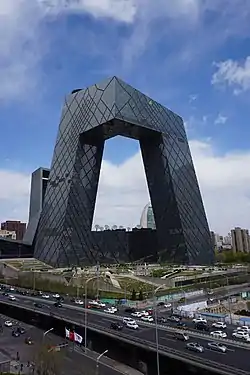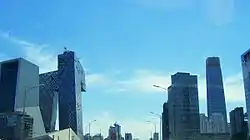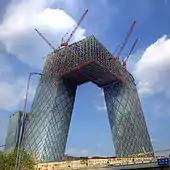CCTV Headquarters
The CCTV Headquarters serves as the headquarters for China Central Television (CCTV) that was formerly at the old China Central Television Building located at 11 Fuxin Road some 15 km (9.3 mi) to the west. The tower is a 234-metre (768 ft), 51-story skyscraper on East Third Ring Road, Guanghua Road in the Beijing Central Business District (CBD). Groundbreaking took place on 1 June 2004 and the building's facade was completed in January 2008. After the construction was delayed by a fire that engulfed the adjacent Television Cultural Center in February 2009, the headquarters was completed in May 2012[5] and was officially inaugurated in June 2013. The CCTV Headquarters won the 2013 Best Tall Building Worldwide from the Council on Tall Buildings and Urban Habitat.
| CCTV Headquarters | |
|---|---|
中央广播电视总台光华路办公区 | |
 CCTV Headquarters | |

| |
| Alternative names | China Central Television Headquarters China Media Group (CMG) Office Block at Guanghua Road Central Chinese Television Tower |
| General information | |
| Location | East Third Ring Road Guanghua Road Beijing, China |
| Coordinates | 39.91347°N 116.45805°E |
| Construction started | 1 June 2004 |
| Completed | 16 May 2012 |
| Owner | China Media Group |
| Management | China Media Group |
| Height | |
| Roof | 234 m (768 ft) |
| Technical details | |
| Floor count | 51 3 below ground |
| Floor area | 389,079 m2 (4,188,010 sq ft) |
| Lifts/elevators | 75 |
| Design and construction | |
| Architect | Office for Metropolitan Architecture East China Architectural Design & Research Institute |
| Developer | China Media Group |
| Structural engineer | Ove Arup & Partners |
| Main contractor | China State Construction and Engineering Corporation |
| References | |
| [1][2][3][4][5] | |
| CCTV Headquarters | |||||||
|---|---|---|---|---|---|---|---|
| Traditional Chinese | 中央廣播電視總台光華路辦公區 | ||||||
| Simplified Chinese | 中央广播电视总台光华路办公区 | ||||||
| |||||||
Rem Koolhaas and Ole Scheeren of OMA were the architects in charge for the building, while Cecil Balmond at Arup provided the complex engineering design.
Background
The main building is not a traditional tower, but a loop of six horizontal and vertical sections covering 473,000 m2 (5,090,000 sq ft) of floor space, creating an irregular grid on the building's facade with an open center. The construction of the building is considered to be a structural challenge, especially because it is in a seismic zone. Rem Koolhaas has said the building "could never have been conceived by the Chinese and could never have been built by Europeans. It is a hybrid by definition".[6] Because of its radical shape, it is said that a taxi driver first came up with its nickname dà kùchǎ (大裤衩), roughly translated as, "big boxer shorts".[7] Locals often refer to it as "big pants". A Chinese critic said that the structure was modeled after a pornographic image of a woman on her hands and knees, which Koolhaas has officially denied.[8]
The building was built in three buildings that were joined to become one and a half buildings on 30 May 2007. In order not to lock in structural differentials this connection was scheduled in the early morning when the steel in the two towers cooled to the same temperature.[9] The CCTV building was part of a media park intended to form a landscape of public entertainment, outdoor filming areas, and production studios as an extension of the central green axis of the CBD.[10]
The Office for Metropolitan Architecture won the contract from the Beijing International Tendering Co. to construct the CCTV Headquarters and the Television Cultural Center by its side on 1 January 2002, after winning an international design competition. The jury included architect Arata Isozaki and critic Charles Jencks.[11] It is among the first of 300 new towers in the new Beijing CBD. Administration, news, broadcasting, and program production offices and studios are all contained inside.
CCTV Headquarters was officially opened by the Chairman on 1 January 2008. Among the distinguished guests at the opening were Hu Jintao, Jiang Zemin, Wen Jiabao and Guo Jinlong.
2009 fire
An adjacent building in the complex, the Television Cultural Center, caught on fire, ignited by fireworks on Lantern Festival day, 9 February 2009, before the building's scheduled completion in May 2009. It was to have the Beijing Mandarin Oriental Hotel, a visitor's center, a large public theatre, two recording studios with three audio control rooms, a digital cinema and two screening rooms. The 160 m (520 ft) Mandarin Oriental Hotel was badly damaged and one fire fighter was killed.[12][13] The director of the project and 19 others were imprisoned.[8] On 25 October 2009, scaffolds were set up in the front gate of CCTV which indicated the renovation of the building had begun. As of 9 February 2010, the main CCTV tower was still unoccupied.[14]
 Beijing's CBD with the CCTV tower and China World Trade Center Tower 3 nearing completion (July 2008)
Beijing's CBD with the CCTV tower and China World Trade Center Tower 3 nearing completion (July 2008) CCTV headquarters in China, Beijing district nearing completion (April 2008)
CCTV headquarters in China, Beijing district nearing completion (April 2008) CCTV Headquarters complete (2009)
CCTV Headquarters complete (2009)
See also
- China Media Group Headquarters (former CCTV headquarters)
- Central Radio & TV Tower
- Diagrid
References
- "CCTV Headquarters". CTBUH Skyscraper Center.
- CCTV Headquarters at Emporis
- "CCTV Headquarters". SkyscraperPage.
- CCTV Headquarters at Structurae
- Associated Press (16 May 2012). "China's distinctive CCTV headquarters is completed". The Guardian. Retrieved 7 July 2012.
- Fraioli, Paul (2012), "The Invention and Reinvention of the City: An Interview with Rem Koolhaas", Journal of International Affairs, 65 (2): 113–119, ISSN 0022-197X
- Paul Goldberger (30 June 2008). "Forbidden Cities: Beijing's great new architecture is a mixed blessing for the city". The New Yorker. Retrieved 18 October 2010.
- NICOLAI OUROUSSOFF (11 July 2011). "Koolhaas, Delirious in Beijing". The New York Times. Retrieved 18 October 2014.
- Lecture by Ole Scheeren from the OMA, Design Academy Eindhoven, 17 October 2007
- "China Central Television (CCTV) Headquarters". Arup. Retrieved 18 October 2010.
- designbuild-network, retrieved 18 May 2012
- Andrew Jacobs (10 February 2009). "Fire Ravages Renowned Building in Beijing". The New York Times. Retrieved 18 October 2010.
- "Who set fire to the CCTV tower?". GB Times. Archived from the original on 13 December 2014. Retrieved 18 October 2010.
- Sky Canaves (9 February 2009). "China Prepares to Salvage CCTV Tower". The Wall Street Journal. Retrieved 18 October 2010.
External links
| Wikimedia Commons has media related to CCTV Headquarters (2010). |